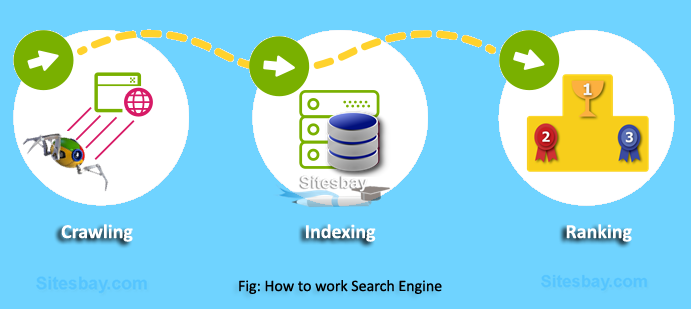How do search engines actually work?
When someone has a question and wants to look up the answer online, they use search engines. Search engine algorithms are computer programmes that sift through data to provide users with the precise results they want. To identify websites and choose which ones to rank for a particular keyword, search engines use algorithms. In order to find information, search engines go through three stages: crawling, indexing, and ranking. Crawling is the discovery stage; indexing, the filing stage; and ranking, the retrieval stage.
Step 1: Crawling
Crawling is the initial action. Web crawlers are sent out by search engines to discover new pages and collect data on them. These web crawlers are sometimes known as robots or spiders. Their aim is to find new web sites that are available and to frequently check previously viewed pages to determine if the material has changed or been updated.
Search engines use links they've already found to crawl web pages. When a search engine searches your homepage, it will look for another link to follow and may follow the link to your new blog post if you have a blog post that is connected from there.
Step 2: Indexing
The second step is indexing. A search engine determines whether or not to use the content it has crawled during the indexing process. A search engine will include a crawled web page in its index if it determines that it is worthy. At the end of the ranking process, this index is employed. A web page or other piece of material that has been indexed is filed and saved in a database so that it can be retrieved later. Most websites that offer distinctive and valuable information are indexed. A website could be excluded from the index if:
- Its contents are regarded as duplicates.
- Its content is regarded as being of low quality or spam.
- No one could crawl over it.
- There were no outside links to the page or domain.
Step 3: Ranking
The ranking comes as the third and ultimately most crucial phase. Only once crawling and indexing are finished can ranking take place. Your website can be ranked once a search engine has crawled and indexed it.
More than 200 ranking factors are used by search engines to categorize and rank content, and they all fall under one of the three SEO pillars: technical, on-page, or off-page optimization. Search engines employ a variety of signals to determine how to rank websites, as follows:
- Keyword presence in title tag – Whether the keyword or a synonym was mentioned on the page and within the title tag
- Loading speed of web page – Whether the web page loads quickly and is mobile-friendly
- Website reputation – Whether the web page and website are considered reputable for the topic being searched for
Ordering and ranking results
The Google Hummingbird main search algorithm is in charge of selecting the rankings and order of search engine results.
Additionally, Google uses RankBrain, a machine-learning search engine sub-algorithm:
- RankBrain uses artificial intelligence to connect unfamiliar words and phrases to similar search requests in order to better understand them.
- By transforming keywords into well-known themes and concepts, it enables Google to comprehend these inquiries, enabling it to deliver better search engine results—even for unique queries.
- Websites that satisfy users and deliver the expected results are rewarded by RankBrain rather than those that try to rank as the best keyword-optimized result.
Getting the most out of RankBrain
An effective SEO plan entails optimizing your website to increase customer pleasure and experience as well as to make the most of the RankBrain ranking element.
The three best methods for doing this are as follows:
- Consider medium-tail keyword optimization (key terms consisting of two to three words).
- Create clickable page names and descriptions to increase the likelihood that people will click on your listing when searching. The percentage of people who find you on Google and then click over to your website is known as the click-through rate.
- Increase dwell time (how long visitors stay on the page) and decrease bounce rate using content optimization (the percentage of visitors who leave after only viewing one page).
Remember, Google’s top three ranking factors are:
- Links
- Content
- RankBrain

pro@msgclub.co.in
ReplyDelete